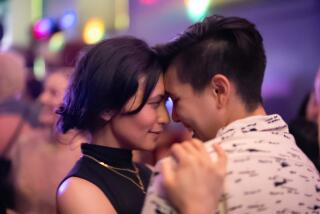Gay programming has arrived -- for a price
- Share via
It might not be as headline-grabbing as the coming out of Ellen DeGeneres’ character on ABC’s “Ellen” six years ago, or, perhaps, even the kiss shared by gay partners Marc Shaiman and Scott Wittman during CBS’ Tony Awards telecast to celebrate their award for the songs in “Hairspray.”
But something deeper and more important has been happening in the way homosexuality is being portrayed on television: Viewers are being offered some of the most enlightened images of gay, lesbian and transgendered identity ever -- but only on those cable channels for which viewers are paying a premium.
If nothing else, programming this month -- Gay Pride Month -- has brought into sharper focus the growing disparity between images of gay and lesbian life as seen on pay cable versus those on “free” broadcast television.
“If you look at pay cable, there is all this interesting and sometimes wonderful stuff starting to happen. But, more and more, it’s happening only on cable, as opposed to network TV,” said Suzanna Danuta Walters, a Georgetown University professor of women’s studies and author of “All the Rage: The Story of Gay Visibility in America.” Although Walters singled out such series as “Six Feet Under” (HBO) and “Queer as Folk” (Showtime), the pattern extends beyond weekly series to made-for-TV movies, documentaries and concerts -- covering the primary genres of cable television.
In such programs as the Showtime movie “Soldier’s Girl” and the Cinemax documentary “Ruthie & Connie: Every Room in the House” -- even Ellen DeGeneres’ HBO special Saturday night, “Here and Now” -- the lives of gay, lesbian and transgendered people are connected culturally and politically to a larger community, which gives them meaning and context.
Furthermore, these people are not defined primarily in opposition to or deviation from the dominant culture. These are crucial criteria in judging images of gay and lesbian identity in the media, Walters said.
Indeed, they are key in judging media representations of any minority, and are the same benchmarks, for example, used by Donald Bogle to access television images of African Americans in his book “Prime Time Blues: African-Americans on Network Television.”
Bogle praises “The Cosby Show,” for example, for being “subtly and brilliantly contextualized with African-American cultural signs and references.”
As Walters puts it in applying the principles to gay identity, “One of the measures of really progressive gay representations is when gays are not just tokenized accessories to heterosexual life, but are depicted as producing, living in and benefiting from a rich and vibrant multicultural gay community. And that’s what you are starting to see on pay cable.”
More to Read
The complete guide to home viewing
Get Screen Gab for everything about the TV shows and streaming movies everyone’s talking about.
You may occasionally receive promotional content from the Los Angeles Times.






